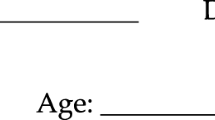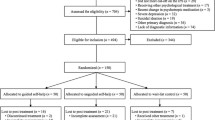Abstract
Assertive behavior is most often assessed with self-report or role-play measures. The latter modality is preferred because it provides for the sampling of the structure of behavior and for the consideration of the situational context. MacDonald (1978) has developed such an assessment device but it is limited by the length of time for administration and scoring. Two studies were conducted to reconstruct reliable alternate short forms. The first study describes the selection of items and demonstrates the internal consistency of the alternate forms. The second study demonstrates the alternate form and retest reliability and provides normative statistics. We conclude that reliable alternate short forms have been constructed to be used in research in clinical applications.
Similar content being viewed by others
References
Barlow, D. H., Hayes, S. C., & Nelson, R. D. (1984).The scientist-practitioner: Research and accountability in clinical and educational settings. New York: Pergamon Press.
Bellack, A. S., Hersen, M., & Turner, S. M. (1979). Relationship of role playing and knowledge of appropriate behavior to assertion in the natural environment.Journal of Consulting and Clinical Psychology, 47, 670–678.
Bem, S. L. (1974). The measurement of psychological androgyny.Journal of Consulting and Clinical Psychology, 42, 155–162.
Bourque, P., & Ladouceur, R. (1979). Self-report and behavioral measures in the assessment of assertive behavior.Journal of Behavior Therapy and Experimental Psychiatry, 10, 287–292.
Chambliss, D. L., Hunter, K., & Jackson, A. (1982). Social anxiety and assertiveness: A comparison of the correlations in phobic and college student samples.Behavior Research and Therapy, 20, 403–404.
Cone, J. (1981). Psychometric considerations. In M. Hersen & A. S. Bellack (Eds.),Behavioral assessment: A practical handbook (2nd ed., pp. 38–68). New York: Pergamon Press.
Craighead, L. W. (1979). Self-instructional training for assertive-refusal behaviors.Behavior Therapy, 10, 529–542.
Eisler, R. M., Miller, P. M., & Hersen, M. (1973). Components of assertive behavior.Journal of Clinical Psychology, 29, 295–299.
Galassi, J. P., DeLo, J. S., Galassi, M. D., & Bastien, S. (1974). The College Self-Expression Scale: A measure of assertiveness.Behavior Therapy, 5, 165–171.
Hammen, C. L., Jacobs, M., Mayol, A., & Cochran, S. D. (1980). Dysfunctional cognitions and the effectiveness of skills and cognitive-behavioral assertion training.Journal of Consulting and Clinical Psychology, 48, 685–695.
Hartmann, D. (1977). Considerations in the choice of interobserver reliability estimates.Journal of Applied Behavioral Analysis, 10, 103–116.
Higgins, R. L., Alonso, R. R., & Pendleton, M. G. (1979). The validity of role-play assessments of assertiveness.Behavior Therapy, 10, 655–662.
Higgins, R. L., Pirsch, M. B., & Smith, D. S. (1983). A comparison of role-play and natural responses to identical circumstances.Behavior Therapy, 14, 158–169.
Hollandsworth, J. G., Galassi, J. P., & Gay, M. L. (1977). The Adult Self-Expression Scale: Validation using the multitrait-multimethod procedure.Journal of Clinical Psychology, 33, 407–415.
Jacob, T. (1976). Assessment of marital dysfunction. In M. Hersen & A. S. Bellack (Eds.),Behavioral assessment: A practical handbook (pp. 397–417). New York: Pergamon Press.
Kern, J. M., & MacDonald, M. (1980). Assessing assertion: An investigation of construct validity and reliability.Journal of Consulting and Clinical Psychology, 48, 532–534.
Kern, J. M., Miller, C., & Eggers, J. (1983). Enhancing the validity of role-play tests: A comparison of three role-play methodologies.Behavior Therapy, 14, 482–492.
Kralik, K., & Lohr, J. M. (1984).The relationship of masculine and feminine sex-role characteristics to role-play and self-report measures of positive and negative assertion. Paper presented at the 56th Annual Convention of the Midwestern Psychological Association, Chicago, May.
Linehan, M. (1979). Structured cognitive-behavioral treatment of assertion problems. In P. C. Kendall & S. P. Hollon (Eds.),Cognitive-behavioral interventions: Theory, research and procedures. New York: Academic Press.
Linehan, M., Goldfried, M. R., & Goldfried, A. P. (1979). Assertion therapy: Skill training or cognitive restructuring?Behavior Therapy, 10, 372–388.
Lipinsky, D., & Nelson, R. (1974). Problems in the use of naturalistic observation as a means of behavioral assessment.Behavior Therapy, 5, 341–351.
Lohr, J. M., & Nix, J. (1982). Relationship of assertiveness and the short form of the Bem Sex-Role Inventory: A replication.Psychological Reports, 50, 114.
Lohr, J. M., Nix, J., Dunbar, D., & Mosesso, L. (1984). The relationship of assertive behavior in women and a validated measure of irrational beliefs.Cognitive Therapy and Research, 8, 287–297.
MacDonald, M. L. (1978). Measuring assertion: A model and method.Behavior Therapy, 9, 889–899.
MacDonald, M. L., & Tyson, P. (1984). The College Women's Assertion Sample (CWAS): A cross-validation.Educational and Psychological Measurement, 44, 405–412.
Nie, N., Hull, C. H., Jenkins, J. G., Steinbrenner, K., & Bent, D. H. (1975).Statistical package for the social sciences (2nd ed.). New York: McGraw-Hill.
Nix, J. (1981).The relationship of sex role characteristics to assertion training outcome in female college students, Unpublished doctoral dissertation. Fayetteville: University of Arkansas-Fayetteville.
Nix, J., & Lohr, J. M. (1985).Modification of assertiveness and sex-role characteristics as a function of skill and sex-role awareness training. Paper presented at the 31st Annual Convention of the Southeastern Psychological Assocation, Atlanta, GA, April.
Nix, J., Lohr, J. M., & Stauffacher, R. (1980). Relationship of sex, sex-role orientationa nd a self-report measure of assertiveness in college students.Psychological Reports, 47, 1239–1244.
Nix, J., Lohr, J. M., & Mosesso, L. (1983). The relationship of sex-role characteristics to self-report and role-play measures of assertiveness in women.Behavioral Assessment, 6, 89–93.
Nunnally, J. C. (1978).Psychometric theory (2nd ed.). New York: McGraw-Hill.
Payne, R. W., & Gwynne-Jones, H. (1966). Statistics for the investigation of individual cases. In R. D. Savage (Ed.),Readings in clinical psychology (pp. 513–521). London: Pergamon Press.
Rathus, S. A. (1973). A 30-item schedule for assesing assertive behavior.Behavior Therapy, 4, 398–406.
Rehm, L. P., Fuchs, C. Z., Roth, D. M., Kornblith, S. J., & Romano, L. P., Fuchs, C. Z., Roth, D. M., Kornblith, S. J., & Romano, J. M. (1979). A comparison of self-control and assertion skills treatments of depression.Behavior Therapy, 10, 429–442.
Rodriguez, R., Neitzel, M. T., & Berzins, J. I. (1980). Sex-role orientation and assertiveness among female college students.Behavior Therapy, 11, 353–366.
Schwartz, R. M., & Gottman, J. M. (1976). Toward a task analysis of assertive behavior.Journal of Consulting and Clinical Psychology, 44, 910–920.
Warren, N. J., & Gilner, F. H. (1978). Measurement of positive assertive behaviors: The Behavioral Test of Tenderness Expression.Behavior Therapy, 9, 178–184.
Wells, R. D., & Kiecolt, J. (1979, December).Sex differences in assertion: A clarification. Paper presented at the Annual Meeting of the Association for the Advancement of Behavior Therapy, San Francisco, CA.
Westefeld, J. S., Galassi, J. P., & Galassi, M. D. (1980). Effects of role-playing instructions on assertive behavior: A methodological study.Behavior Therapy, 11, 271–277.
Author information
Authors and Affiliations
Additional information
This research was supported by the Marie Wilson Howells Fund.
Alternate short forms of the CWAS may be obtained from the first author.
Rights and permissions
About this article
Cite this article
Lohr, J.M., Nix, J., Bonge, D. et al. Internal consistency and reliability of alternate short forms of the college women's assertion sample: Clinical and research implications. J Psychopathol Behav Assess 12, 129–142 (1990). https://doi.org/10.1007/BF00960762
Accepted:
Issue Date:
DOI: https://doi.org/10.1007/BF00960762




